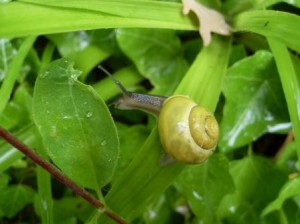At a snail’s pace
It’s one of the mini beasts that people find easiest to identify but did you know there are tens of different species of snail in Britain?
The wet weather has been great for these slimy critters and we’ve seen a large variety around the reserve. Their shells come in an array of colours and patterns.

This fellow is a brown lipped snail (Cepaea nemoralis). The key feature to identify one of these is that the shell has a brown lip to it, which you can only really see from underneath. It has a conical, rather than a flat shell, which can be almost translucent. Colours are normally pale yellow, like this one, but they can also be pinkish.
The interesting thing about these snails is that depending on where you are in the country, the shell can have different stripe patterns on. This one has no clear stripes, where as other varieties include single striped, multi-striped and thick striped.
Like the woodlouse I found last week, snails have an exoskeleton which is their shell. Unlike woodlice they don’t have to shed it to grow. They keep secreting the substance calcium carbonate and slowly build their skeleton around them.
Bye for now,
Rhian – Seasonal Ranger
Help protect Scotland’s wildlife
Our work to save Scotland’s wildlife is made possible thanks to the generosity of our members and supporters.
Join today from just £3 a month to help protect the species you love.
Preface
It’s one of the mini beasts that people find easiest to identify but did you know there are tens of different species of snail in Britain? The wet weather has …
